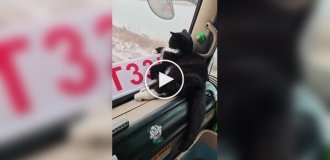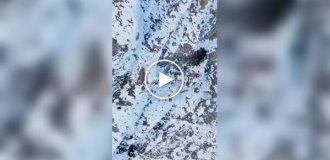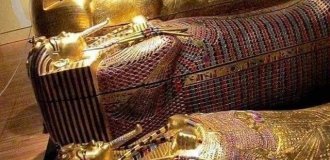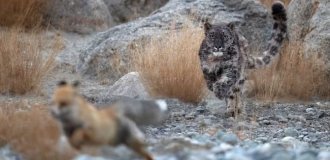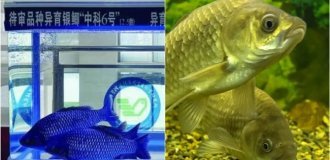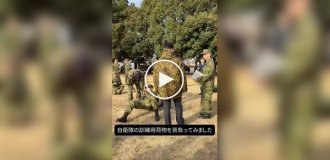Animals rule Chernobyl after nuclear disaster (12 photos)
30 years after the largest accident in the history of nuclear energy at the Chernobyl nuclear power plant, the territory became a wasteland. Who is left to own the lands of Chernobyl? Are there really such crazy people left? - As it turned out, they remained. Only these are not madmen at all, but truly real inhabitants of planet Earth, namely, our smaller brothers - animals. The animal world began to rule the contaminated Earth.
Przewalski's horse
The Przewalski's horse is an endangered species. In an attempt to save this species, it was introduced into the area around the Chernobyl nuclear power plant in 1998. Without people living in the area, the horse population began to increase.

Wolves
Due to limited human activity, the surrounding landscape now supports a large population of wolves.

Photographing a wolf with a hidden camera while the free predator was fishing.

Black stork
We all know the white stork well, but how many of you have seen the black one? They live on Chernobyl territory.

A herd of wild boars in an abandoned village.

Gray crane

Grouse
Among all the representatives of the chicken tribe known in the zone, this “Red Book” species, however, is the most common, and in its own way even numerous.

Lesser Spotted Eagle
Unlike the black stork, which often roams the ground, the spotted eagle descends there on rare occasions.

The low levels of radiation characteristic of the Chernobyl nuclear power plant area today negatively affect the lives of individual animals.
Prolonged exposure to small doses of radiation on the body of wild animals in the “exclusion zone” around the Chernobyl nuclear power plant often leads to the development of cataracts and other eye problems leading to complete or partial blindness, say Finnish radiologists who published an article in the journal Scientific Reports, RIA Novosti reports.

Lynx
Lynxes feel good in the Chernobyl zone.

The Bears
Bears returned to Chernobyl after a century-long absence
Ukrainian scientists claim that wildlife is being restored in the Chernobyl zone - in particular, brown bears, unique to Ukraine, have reappeared there.
Although, as biologist Sergei Gashchak from the Chernobyl Center for Nuclear Safety, Radioactive Waste and Radioecology told the BBC Ukrainian Service, the state still does not conduct serious research here.
He has been working in the exclusion zone since 1990 and claims that scientific work there is mainly carried out by enthusiasts.
Despite the radiation, the absence of people in the zone does its job: unique species of animals and birds appear there.
The number of moose, deer, wolves, lynxes, as well as Przewalski's horses, which were brought here in the nineties, is growing.

Today, within a radius of tens of kilometers from a nuclear power plant, it is not so easy to meet a person, but, as new studies show, there are plenty of wild animals in the exclusion zone. Scientists from the Savannah River Ecological Laboratory (University of Georgia) studied and counted Chernobyl fauna using camera traps.
The results of the research, carried out under the direction of James Beasley, were published in the journal Frontiers, which specializes in ecology and environmental protection. The scientists' work confirmed a long-standing assumption that the number of animals in the exclusion zone does not decrease even in places of significant radiation contamination.
In previous studies on this topic, published in the fall of 2015, the number of animals was determined by counting their tracks. Beasley's group used a more modern technique based on remote photography. It is noteworthy that Beasley's data are in good agreement with earlier studies.
“We placed cameras in a strict order throughout the Belarusian section of the exclusion zone,” says Beasley. “Thanks to this, we now have photographic evidence to support our conclusions.”
The study was carried out over five weeks at 94 sites using 30 cameras. The devices attached to trees worked for 7 days in each location. To attract animals, camera traps emitted the smell of fatty acids.
Sarah Webster, a Beasley graduate student, set up the devices about three kilometers apart to ensure the animals visited no more than one camera trap per day.
Scientists recorded each animal species captured in the photographs, as well as the frequency of their appearance. At the same time, Beasley's group paid special attention to carnivores because of their special place in the food hierarchy. By closing the food chain, predators are most at risk of radiation contamination. They not only eat animals living in the exclusion zone, but also receive radioactive substances from the environment - soil, water and air.
Scientists managed to capture 14 species of mammals in photographs. Most often, wolves, wild boars, foxes and raccoon dogs, widespread on the Eurasian continent, were caught on camera lenses. According to Beasley, these animals were most often found precisely in those parts of the exclusion zone where radiation contamination was maximum.
In further research, Beasley plans to find out how living in the exclusion zone affects the physical condition and life expectancy of animals.

